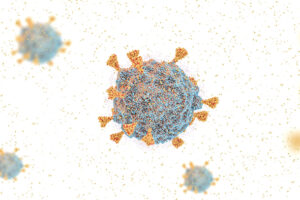Infectious Diseases
Influenza
Antimicrobial Update: Current Susceptibility Data and Trends
Overview
Two speakers shared in presenting an on-demand session titled “New Bugs, New Drugs” at the 2020 AAP Virtual National Conference & Exhibition. Rana E. El Feghaly, MD, MSCI, FAAP, provided antimicrobial updates in select infections in the outpatient setting, while Jennifer L. Goldman, MD, MS, FAAP, focused primarily on inpatient infections.
Following the presentation, our featured expert, Mark H. Sawyer, MD, FAAP, FIDSA, was interviewed by Conference Reporter Editor-in-Chief Tom Iarocci, MD. Dr Sawyer’s clinical perspectives on this session are presented here.
Mark H. Sawyer, MD, FAAP, FIDSA
|
|
“In addition to the judicious use of antibiotics, vaccines may also play a role in combating the development of antibiotic resistance.”
As suggested by the title “New Bugs, New Drugs,” some of the discussion in this session related to several recently introduced antibiotics. Dr Goldman noted that a number of newer antibiotics have been approved by the US Food and Drug Administration since 2015; however, only one of them is available for children. This underscores the importance of antimicrobial stewardship, a theme that both speakers explored during the course of the session.
The overuse of antibiotics in the outpatient setting is widely acknowledged, particularly for upper respiratory tract infections. I believe that one of the problems is that the health care community underestimates the impact of such overuse. We all know about stomachaches and rashes from antibiotics, but there are more severe adverse consequences of antibiotics that primary care physicians do not see very often, and severe Clostridium difficile colitis is one of them. Further, without the appropriate selection and judicious use of antibiotics, we are creating highly resistant organisms that can lead to infections that are nearly untreatable; we now have multidrug-resistant urinary tract infections in children who present to the pediatric Emergency Department. The other elephant in the room is the issue of the microbiome. Emerging data suggest that the microbiome may be important in disease, particularly in chronic inflammatory disease. We do not want to be disturbing the microbiome of children by administering antibiotics inappropriately, as this could potentially contribute to the development and/or severity of chronic illnesses.
In addition to the judicious use of antibiotics, vaccines may also play a role in combating the development of antibiotic resistance. As more vaccines to prevent infectious disease are introduced, the burden of disease that drives people to seek antibiotics should decrease. Consider combined viral and bacterial infections, specifically co-infection, which is well described with influenza. One of the most important reasons to get an influenza vaccine is to avoid the situation of potentially getting more severe illness by co-infection with bacteria. Both the influenza vaccine and the pneumococcal vaccine have been shown to decrease the risk of otitis media, so these and other advances may help to chip away at antimicrobial overuse and related issues.
It is much more effective and cost-effective to develop a vaccine and prevent an infection than it is to develop a new antibiotic in an attempt to treat an infection after resistance emerges, because, as we have learned, the organisms do not remain susceptible to the antibiotic for very long. Turning to antiviral drug resistance, while resistance to the neuraminidase inhibitors (eg, oseltamivir) has not arisen as a problem, we need to keep monitoring for drug resistance in influenza, especially if we continue to treat it aggressively as is recommended by the American Academy of Pediatrics and the Centers for Disease Control and Prevention.
From the public health perspective, the biggest value for the money spent is in developing and improving vaccines such as influenza vaccines, SARS-CoV-2 vaccines, and the like. Hopefully, we will continue to focus on vaccine prevention as a high priority for public health.
References
Centers for Disease Control and Prevention. Children and flu antiviral drugs. Accessed October 13, 2020. https://www.cdc.gov/flu/highrisk/children-antiviral.htm
El Feghaly RE, Goldman JL. New bugs, new drugs. On-demand session presented at: 2020 American Academy of Pediatrics Virtual National Conference & Exhibition; October 2-5, 2020.
Gaufin T, Tobin NH, Aldrovandi GM. The importance of the microbiome in pediatrics and pediatric infectious diseases. Curr Opin Pediatr. 2018;30(1):117-124. doi:10.1097/MOP.0000000000000576
Havers FP, Hicks LA, Chung JR, et al. Outpatient antibiotic prescribing for acute respiratory infections during influenza seasons. JAMA Netw Open. 2018;1(2):e180243. doi:10.1001/jamanetworkopen.2018.0243
Klugman KP, Black S. Impact of existing vaccines in reducing antibiotic resistance: primary and secondary effects. Proc Natl Acad Sci U S A. 2018;115(51):12896-12901. doi:10.1073/pnas.1721095115
Mahony M, McMullan B, Brown J, Kennedy SE. Multidrug-resistant organisms in urinary tract infections in children. Pediatr Nephrol. 2020;35(9):1563-1573. doi:10.1007/s00467-019-04316-5
Norhayati MN, Ho JJ, Azman MY. Influenza vaccines for preventing acute otitis media in infants and children. Cochrane Database Syst Rev. 2017;10(10):CD010089. doi:10.1002/14651858.CD010089.pub3
Short KR, Diavatopoulos DA, Thornton R, et al. Influenza virus induces bacterial and nonbacterial otitis media. J Infect Dis. 2011;204(12):1857-1865. doi:10.1093/infdis/jir618
This information is brought to you by Engage Health Media and is not sponsored by, nor a part of, the American Academy of Pediatrics.











